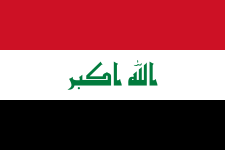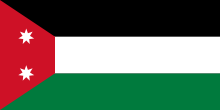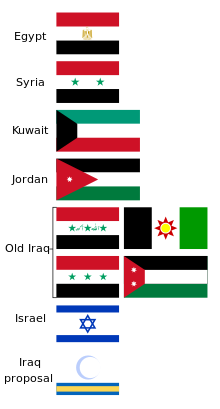Flag of Iraq
 |
| |
|
Use |
National
flag
and
ensign

 |
| Proportion |
2:3 |
| Adopted |
22 January 2008 |
| Design |
A horizontal
tricolour of red, white, and black charged with the
takbir
[Allahu Akbar (God is great) in
Kufic
script] in green centered on the white stripe. |
The flag of Iraq (Arabic:
علم العراق) consists of the
three equal horizontal red, white, and black bands of the
Arab Liberation Flag. The flag has been in use since 1963, with
several changes to the green symbols in the central white band, the most
recent version bearing the
Takbir
rendered in green. Following the U.S. invasion and occupation of Iraq in
2003, there has been considerable debate about the design of the flag.
[edit]
History of the
Iraqi flag
[edit]
19211959

 19211959
(ratio: 1:2)
19211959
(ratio: 1:2)
.svg/220px-Royal_Standard_of_Iraq_(1930-1958).svg.png)
 Royal Standard of the Kingdom of Iraq, 19301958 (ratio: 1:2)
Royal Standard of the Kingdom of Iraq, 19301958 (ratio: 1:2)
The first flag of modern Iraq was that of the
Kingdom of Iraq, and was adopted in 1921. It was a black-white-green
horizontal flag, with a red trapezoid (some variants have a triangle)
extending from the mast side, inspired by the
Flag of the Arab Revolt. Two seven-point white stars on the triangle
denoted the two principal peoples of the kingdom: the Arabs, and the
Kurds. The design also reflected the newly installed
Hashemite Dynasty in Iraq (originally from Hejaz in the
Arabian Peninsula), who had played a leading role in the
Arab Revolt. As such, it was very very similar to the flags of
Hashemite
Jordan, and the short-lived Kingdom of Hejaz. Prior to Iraqi
independence in 1932, this flag was also used by the
British Mandate of Mesopotamia. Today, it is used by pro-Hashemite
monarchists in Iraq.

 1958
(ratio: 1:2)
1958
(ratio: 1:2)
In 1958, in response to the merger of
Egypt and
Syria in
the
United Arab Republic, the two Hashemite kingdoms of Iraq and
Jordan
established the
Arab Federation, a confederation of the two states. The flag of the
union was essentially that of Jordan but without seven pointed star in
the red chevron.[1]
This flag is identical to the
Flag of Palestine adopted in 1964, and almost identical the flag of
the
Ba'ath Party. The union lasted less than six months, being
terminated by the
Iraqi Revolution of 1958 in July
[edit]
19591963

 1959-1963
(ratio: 1:2)
1959-1963
(ratio: 1:2)
Following the Revolution of 14 July 1958, led by
Abdul Karim Qassim, which abolished the Hashemite monarchy in Iraq
and turned the country into a republic,
Iraq adopted a new flag (Law 102 of 1959) that consisted of a
black-white-green vertical tricolour, with a red eight-pointed star with
a yellow circle at its centre. The black, white, green, and red are the
Pan-Arab colours, representing
pan-Arabism, while the yellow sun represented the
Kurdish minority. In addition, the red star (of
Ishtar)
was used to represent Iraq's ancient heritage.
This version of the Iraqi national flag is currently allowed to be
flown in the
Kurdish minority region of Iraq, while the 1963-2007 versions of the
Iraqi flag are not, due to their connotations of
Pan-Arabism, and their adoption during the period of Ba'ath Party
rule.[2][3]
[edit]
19631991
.svg/220px-Flag_of_Iraq_(1963-1991).svg.png)
 19631991 (ratio: 2:3)
19631991 (ratio: 2:3)
After Qassim was overthrown by the Ba'ath Party in 1963, the new
Ba'athist government adopted a modified version of the
Arab Liberation Flag as the new flag of Iraq on 31 July 1963 (Law 28
of 1963). This horizontal tricolour of red, white, and black bands
(first used in the
Egyptian Revolution of 1952) formed the basis of the flag of the
United Arab Republic (UAR). Though the UAR broke up in 1961, hopes
for Arab unity persisted. As such, whereas the UAR flag had two green
stars in the white band, signifying its two component members (Egypt
and Syria)
the new Iraqi flag had three stars, symbolising the aspiration that Iraq
would join with Egypt and Syria in a new union. Sharing this goal, Syria
adopted the new Iraqi flag as its own later that same year. This
remained the
flag of Syria until 1971, when the green stars were replaced by the
Hawk of Qureish.
The Iraqi Flag Law No. 28 of 1963 was replaced by Flag Law No. 33 of
1986, during the presidency of
Saddam Hussein, in which although the flag remained the same, the
meaning of the three stars was changed from their original geographic
meaning to representations of the three tenets of the
Ba'ath party motto, Wahda, Hurriyah, Ishtirakiyah (Unity,
Freedom, Socialism).
[edit]
19912004

 19912004 (ratio: 2:3)
19912004 (ratio: 2:3)
On 13 January 1991, the flag was modified by Flag Law No. 6 of 1991.
At the instigation of
Saddam Hussein, the
Takbir
(the words Allahu Akbar, meaning "God is Great" in Arabic) was
added in green between the stars. The form of the Takbir was allegedly
in Saddam Hussein's own handwriting[citation
needed]. Many[who?]
interpreted the addition of the sacred Islamic text as an attempt to
garner wartime support from previously outlawed religious Iraqi leaders,
to stop the disrespect of the Iraqi flag in Iraqi-occupied Kuwait, and
to bolster the Iraqi Government's Islamic credentials (hitherto strongly
secular) in the period immediately preceding the
Gulf
War[citation
needed].
As with other flags inscribed with
Arabic script, the
hoist is to the right of the obverse (front) of the flag.
[edit]
2004
flag proposal and controversy
.svg/220px-Proposed_flag_of_Iraq_(Coalition_Provisional_Authority,_2004).svg.png)
 Proposed
flag, 2004 (later abandoned)
Proposed
flag, 2004 (later abandoned)

A comparison of the flags of some of Iraq's neighbours, Iraq's
older flags, and the proposed flag.
Following the invasion and occupation of Iraq by the
United States in 2003, the Iraqi Government was overthrown, and the
Ba'ath Party was outlawed. Strong speculation followed that the U.S.
Government would press for a change in the Iraqi flag to remove its
pan-Arab symbolism, and to make a definitive break with the period of
Ba'athist rule. To a degree, this view was shared by some groups in
Iraq. In addition to some displeasure among Iraqis who had suffered
under Saddam Hussein to retaining national symbols used by his
government, there was also strong aversion to the flag from Iraq's
Kurdish minority, who resented its evocation of pan-Arabism. However,
Iraqi opponents of changing the flag argued that since the flag had been
used since 1963, long before Saddam Hussein's presidency, it was unfair
to characterise it as a 'Saddamist' flag. They also stressed that
pan-Arabism has been a dominant popular principle among Iraqi's majority
population for decades prior to Iraqi independence in 1932.
On 26 April 2004 the U.S. appointed
Iraqi Governing Council (IGC) announced a new flag for post-Saddam
Iraq. The IGC stated that, from around 30 competing entries, it had
chosen a design by the distinguished Iraqi artist-architect
Rifat Chadirji, who lives in London, and is a brother of a member of
the IGC.
The proposed flag was white, representing purity, with parallel
blue-yellow-blue bands across the bottom quarter or third; the blue
bands represented the
Tigris
and the
Euphrates rivers, and the yellow represented Iraq's Kurdish minority
(the reason for this symbolism was unclear, but the
flag of Kurdistan does feature a yellow sun). In the middle of the
white field was a large
crescent to represent
Islam,
which was unusually depicted in a shade of blue. The shade of blue
represented the
Iraqi Turkmens.
The design marked a notable break with the three flags of modern
Iraqi history (namely the Arab Revolt-inspired flag of the Kingdom, the
flag introduced by Abdul Karim Qassim, and the Arab Liberation inspired
flag of 1963), all of which were based on the four
Pan-Arab colours. Indeed, of these colours, only white was
represented in the IGC design. Moreover, Islamic crescents are usually
depicted in green or red in Arab heraldry. The proposed change provoked
an intensely negative reaction across groups of Iraq's Arab majority,
including those vehemently opposed to Saddam Hussein. Those opposed to
the U.S. occupation, including
Shi'a cleric
Muqtada Al-Sadr, decried the design as an attempt by the U.S.
Government to strip Iraq of its identity, and its historically prominent
role in the
Arab World. In particular, critics lamented the proposed abandonment
of the Arab Liberation Flag, the omission of the traditional colors of
Pan-Arabism, and the removal of the Takbir.
Additionally, the new flag's predominantly blue-on-white appearance
immediately antagonised many in Iraq because of its alleged resemblance
to the
flag of Israel, considered an enemy of Iraq since the former's
establishment in 1948.
The new flag was reported to have been
burned by insurgents in
Fallujah on 27 April 2004, the day before its planned official
adoption.
On 28 April 2004, IGC President
Massoud Barzani formally presented a modified version of the flag in
which the originally very light shade of blue as reported by the press
on 26 April 2004 had been changed to a darker tone. It was unclear
whether this was a change made because of the protests made against the
original design or, as the Council claimed, a rectification of printing
errors in the earlier news reports. Barzani also explained that the flag
was a temporary design, to be used over the ensuing months until the
adoption of a definitive flag.
In the face of the overwhelming public outcry, adoption of the blue
crescent flag was abandoned entirely.
[edit]
20042008

 20042008, Flag of Iraq with stylized
Kufic
script (ratio: 2:3)
20042008, Flag of Iraq with stylized
Kufic
script (ratio: 2:3)
Due to these differing views, and the prevailing opposition to an
outright abandonment of the current Iraqi flag, a compromise measure was
adopted by the U.S. appointed Iraqi interim administration in 2004. The
basic form of the existing flag was retained,[4]
however, the Takbir was rendered in traditional stylized
Kufic
script, as opposed to the alleged handwriting of Saddam Hussein.
The modified flag was unveiled at the ceremony marking the technical
'handover' of power from the
Coalition Provisional Authority occupation forces to the U.S.
appointed administration on 28 June 2004.[5]
[edit]
Flag proposals,
2008
.svg/220px-Proposed_flag_of_Iraq_(first_proposal,_2008).svg.png)
 First
proposal, 2008
First
proposal, 2008
Despite the compromise in 2004, opposition to the flag persisted from
Kurdish groups. In January 2008, a new design was proposed, removing the
three green stars, instead placing a green eight pointed star around a
yellow circle in the middle of the Takbir, which is written in the Kufic
script and prized as a Mesopotamian Arabic style, having originated in
Iraq.[6]
[edit]
2008 flag contest
.svg/220px-Proposed_flag_of_Iraq_(second_proposal,_2008).svg.png)
 Second
proposal, 2008
Second
proposal, 2008
In July 2008, the Iraqi parliament launched a contest to design a new
Iraqi flag. The contest ran until September 2008, with 50 designs
submitted. Six designs were chosen and sent to the parliament which was
going to choose a new flag before the end of 2008.[7]
Another design was also proposed similar to the 2004-2008 flag, but
the script was changed to yellow to represent the Kurdish people in
northern Iraq. The meaning of the three stars would be changed to
symbolize peace, tolerance and justice.[8]
[edit]
2008present

 2008-present: Flag of Iraq (ratio: 2:3)
2008-present: Flag of Iraq (ratio: 2:3)
On 22 January 2008, a new design for the flag was confirmed by Law 9
of 2008. In this current version, the three stars were removed, while
the Takbir was retained in its 2004 form. The parliament intended that
the new design last for one year, after which a final decision on the
flag would be made. However, the flag law was reviewed in parliament on
30 April 2009.[9]
[edit]
See also
[edit]
External links